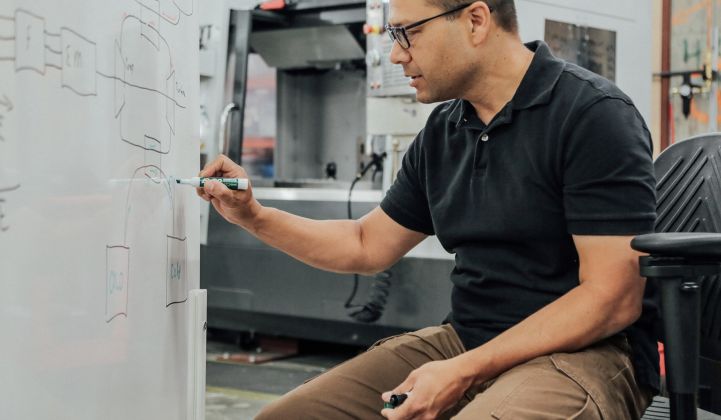Malta has graduated from incubation to long-duration grid storage startup, with a $26 million raise led by the billionaire-backed Breakthrough Energy Ventures. Concord New Energy and Alfa Laval joined the round.
The project started life in X, Alphabet’s far-out R&D lab formerly known as Google X. It differs from both electrochemical storage, like lithium-ion batteries, and from typical thermal energy storage, which converts electricity for heating or cooling.
Malta uses a heat pump to store electricity in hot molten salts and cold antifreeze liquid, then uses a heat engine to convert the energy back to electricity for the grid; electricity goes in and electricity goes out.
Cambridge-based Malta touts this as “an implementation opportunity, not an R&D project.” It plans to use “conventional components and abundant raw materials,” and draw its key machinery from the oil and gas industry.
If successful, this technology would fill a crucial gap: storing renewable energy for days or weeks, a task vital to ambitious clean energy scenarios but out of reach with today’s lithium-ion batteries. Breakthrough founder Bill Gates speaks often about the need for step-change in energy technology to allow humanity to grapple with climate change while supplying the energy needed for a dignified life.
Breakthrough earlier this year invested in Form Energy, a Cambridge-based startup tackling weeks-long storage with aqueous sulfur flow batteries and an undisclosed chemistry. MIT professor Yet-Ming Chiang and former Tesla storage leader Mateo Jaramillo joined forces on that effort, which they say will take five years to prove out and another five to deploy, if it works.
Another Breakthrough recipient, Quidnet, seeks to convert used oil and gas wells into subsurface pumped hydro storage facilities.
By tackling long-duration storage, Malta enters a field that has proven exceptionally difficult thus far.
Lithium-ion batteries dominate nearly all grid storage deployments today, piggy-backing on the electric vehicle industry's mass production to drive down costs. Their economics suffer when extended out to longer durations: They can shift solar power from daytime to the evening, but they can’t store surplus generation from the summer and deliver it in the cloudy winter, or even last for a few days of rainstorms.
Makers of long-duration alternatives must convince cautious utilities that their technology is as trustworthy as the tried and true batteries, which usually requires running pilots for a few years to generate operational data.
Then there’s a market challenge: With few viable products to use, hardly anyone buys long-duration storage these days. Entrepreneurs have to create a product and a market.
Bill Gates alone has funded numerous failed long-duration storage ventures, prompting GTM editor emeritus Eric Wesoff to call Gates' involvement a "kiss of death" for such companies.
Aquion deployed some saltwater batteries and $190 million before running out of money. LightSail Energy spent $80 million to commercialize containerized compressed air storage but didn’t get far beyond a fancy tank. Energy Cache fizzled after building a 50-kilowatt pilot-scale ski lift to hoist rocks up a hill.
Gates-backed Ambri is still alive and recently raised new funding, but its liquid metal batteries are taking a few years longer to commercialize than originally promised.
Other companies have taken Malta’s route of building a product from off-the-shelf components developed by other industries. It makes perfect sense on paper, but experience suggests this tactic alone does not suffice (see: SustainX and General Compression).
Newcomer Energy Vault wants to tap the crane industry to make gravity-based storage plants, where an automatic six-armed crane lifts heavy blocks with excess grid power. It plans to deliver its first megawatt-scale plant for Tata Energy in 2019.
Highview Power took the borrow-rather-than-invent approach with its device to store energy in cooled-down air. The British company completed a 5-megawatt/15 megawatt-hour demo this year (three years later than originally expected) and plans to build a 50-megawatt/200-megawatt-hour facility next.
That company’s experience flags a challenge for these sorts of storage ventures: the off-the-shelf components tend to be built for much larger capacities than initial storage pilots. These startups need to get through the pilot scale to build larger plants before borrowing technology from other industries really pays off.
Longer term, the challenge will be to bring down cost of construction for these power plants compared to the mass-produced batteries that abet fast and cheap installation. The best way to stay ahead of lithium's declining cost curve is to store for much longer than the four hours common for today's battery plants.
If Malta doesn't spend a lot of money and take longer than expected to get a full-scale plant on the grid, it will prove itself an outlier in the field. Then again, that is the whole point of Breakthrough Energy Ventures: to seed technologies that don't make sense for VCs looking to earn a return on investment, but which could fill a gap in decarbonizing society.




